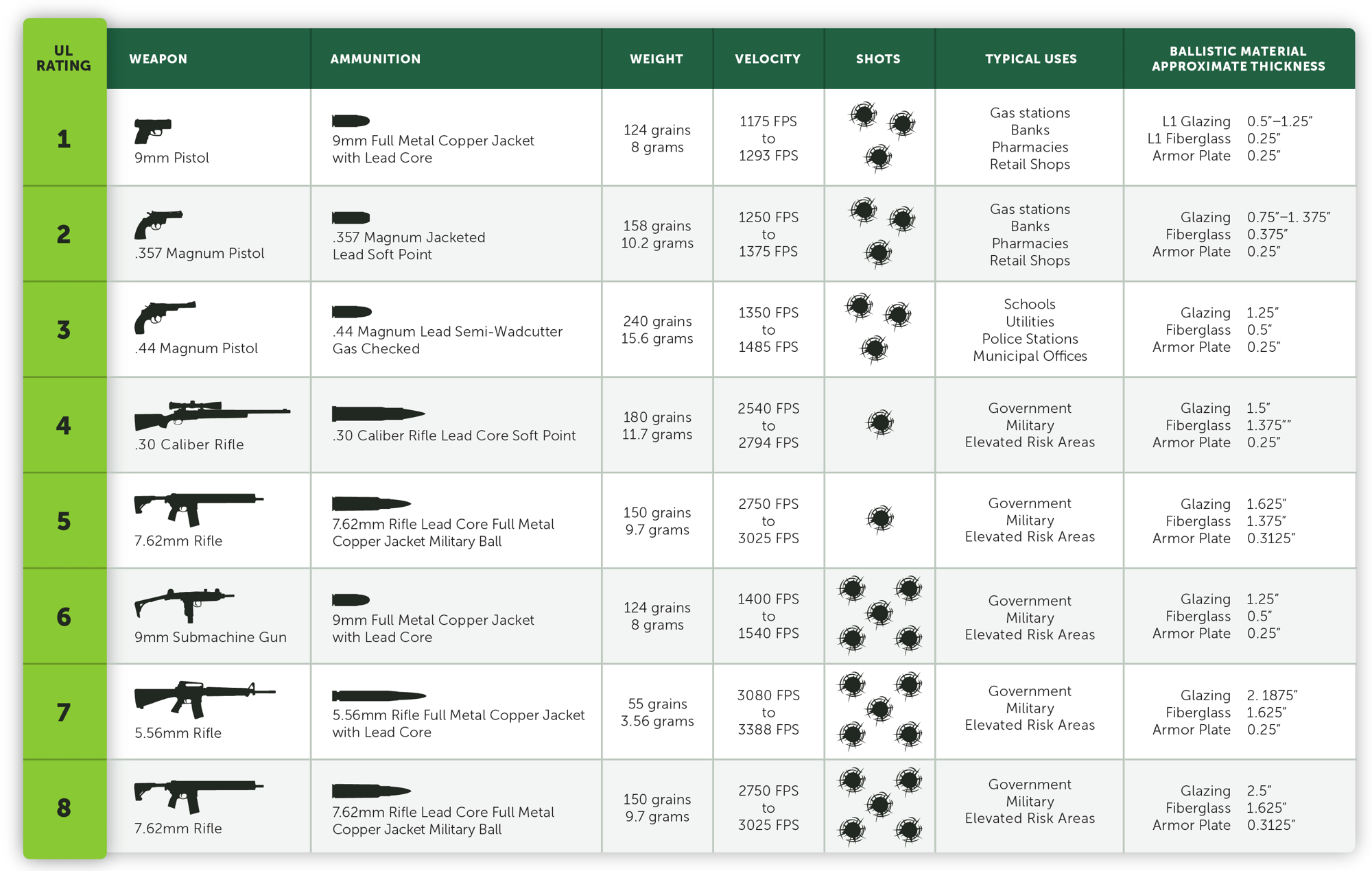Bulletproof and Ballistic Glass
End-to-end consulting, design, fabrication, and installation for your custom bulletproof project.
What is Bulletproof Glass?
Bullet-resistant glass, commonly called bulletproof glass or ballistic glass, is made of transparent materials specially designed to resist the penetration of bullets. The most common types of bulletproof glass are fabricated using acrylic, polycarbonate, actual glass, or laminated layers thereof such as Glass-Clad Polycarbonate.
Unlike traditional glass, ballistically rated glass is typically the center point of more complex bullet-resistant barrier systems like a teller line at a bank, school entrance, convenience store checkouts, or bullet-resistant windows. Understanding the unique qualities of each type of bullet-resistant glazing is essential to choosing the right product for your ballistically protected physical barrier system.
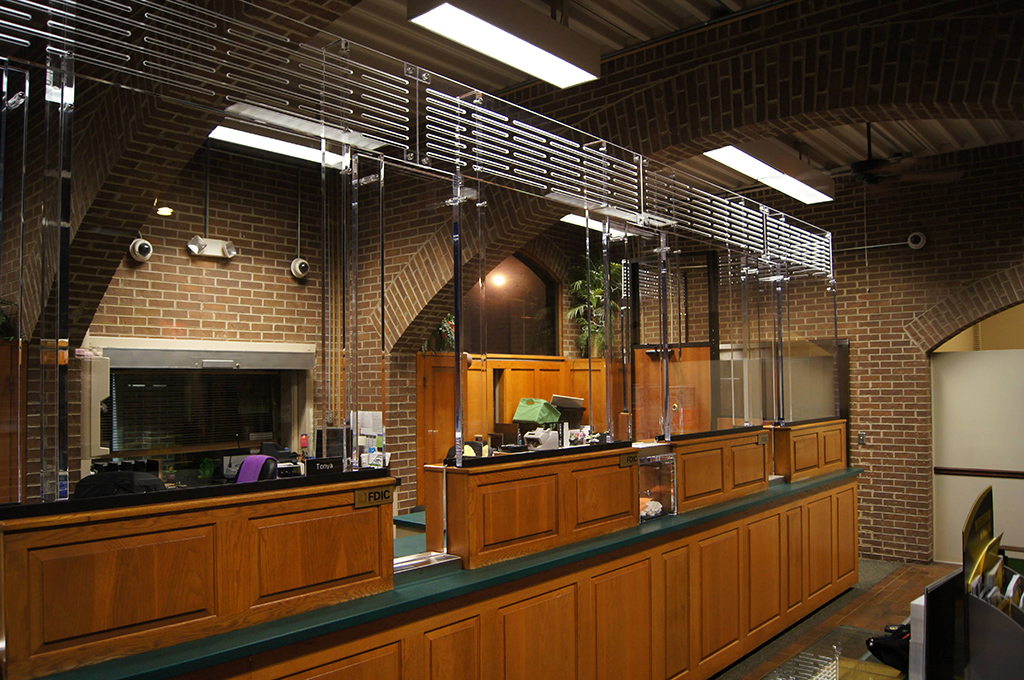
The Four Types of Bulletproof Glass
Choosing the right type of bulletproof glass for your project will depend on specific risk factors, the materials appropriate to the threat level, and the functionality and aesthetics of the building. The most common interior types of bullet-resistant glazing actually use monolithic acrylic or layers of polycarbonate. By carefully selecting which materials to layer in what way, TSS can make bullet-resistant glazings with a wide range of properties and safety levels.
The four most common forms of bullet-resistant glazings are acrylic, polycarbonate, glass-clad polycarbonate, and insulated glass.

Acrylic Glazing
Bullet-resistant glass, commonly called bulletproof glass or ballistic glass, is made of transparent materials specially designed to resist the penetration of bullets. The most common types of bulletproof glass are fabricated using acrylic, polycarbonate, actual glass, or laminated layers thereof such as Glass-Clad Polycarbonate.
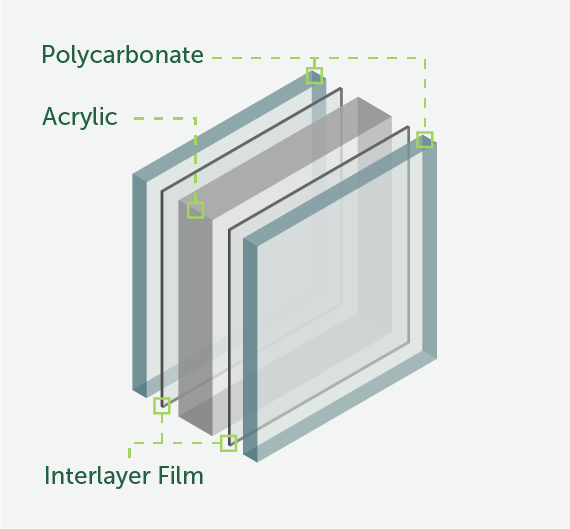
Polycarbonate & Laminated Polycarbonate Glazing
Ballistic polycarbonate is also a popular choice for bulletproof barriers, as it can be thinner yet deliver higher impact protection than acrylic panels. This impact protection applies not only to bullets but also to forced-entry attempts and severe weather events such as hurricanes.
Polycarbonate ballistic glass is recommended for indoor applications and is available in UL levels 1-3.
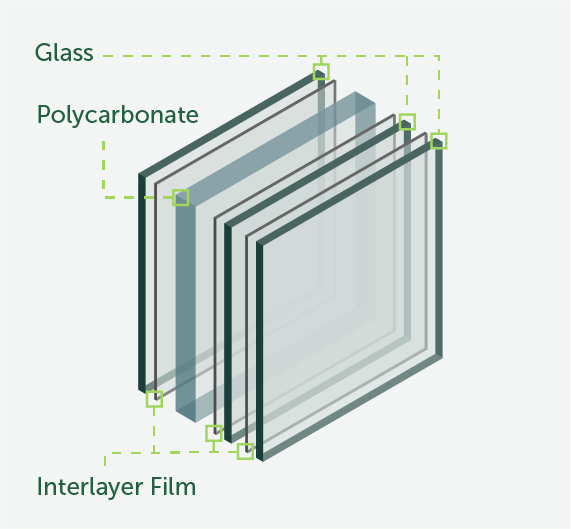
Glass-Clad Polycarbonate Glazing
Glass-clad polycarbonate (GCP) is a high-performance glazing made with layers of glass and polycarbonate. Using polycarbonate layers in the construction yields superior ballistic protection than old school glass-only panels.
Glass-Clad Polycarbonate ballistic glass is recommended for interior and exterior applications and is available in UL Levels 1-8.
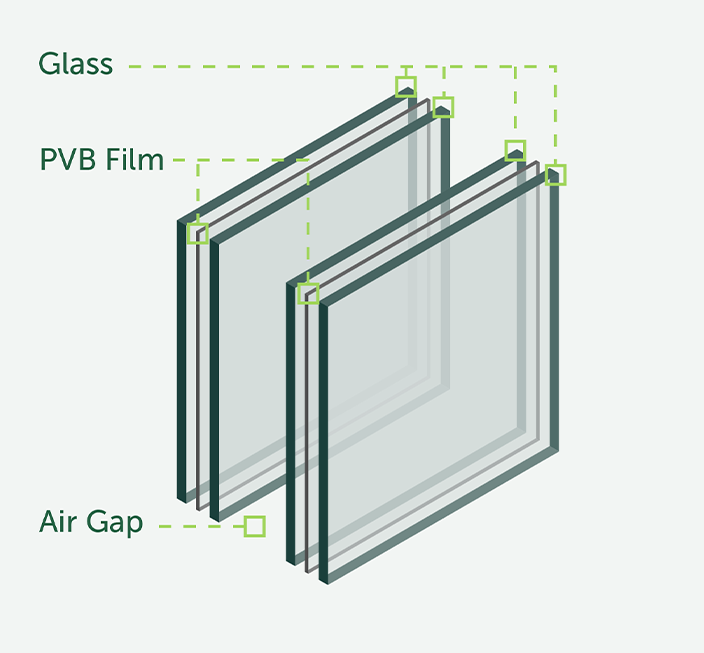
Insulated Glass
A whole new generation of bulletproof glass is now available from Total Security Solutions. The TSS DEFENDER Ballistic Insulated Glass product line meets energy requirements, offers ballistic and forced-entry protection, and is a cost-effective option for ballistically protecting your building’s exterior.
Ballistic insulated glass is recommended for exterior applications and is available in UL Levels 1-8.
Product Comparison Chart
Acrylic |
Polycarbonate |
Glass-Clad Polycarbonate |
Insulated Glass |
|
|---|---|---|---|---|
| Applications | Interior Windows and Doors | Interior Windows and Doors | Interior or Exterior Windows and Doors | Exterior Windows and Doors |
| Thickness | 1 1/4” to 1 3/8” | 3/4” to 1 1/4” | 13/16” to 2 1/2” | 15/16” to 1 1/4” |
| Protection Level |  |
 |
 |
|
| Forced Entry Protection | No | Yes | Yes | Yes |
| Light Transmission | 90% | 80% | 60-75% | 90% |
| Weatherability | Sensitive to exposure and solvents. Abrasion-resistant coating available. |
Sensitive to exposure and solvents. Abrasion-resistant coating available. |
Hightened resistance to weathering and solvent damage. | Hightened resistance to weathering and solvent damage. |
Need help finding the right solution for your project?
We offer complete security solutions custom-designed for your building, from secure entryways and barrier systems to bulletproof windows, walls and counters. Get free advice from our ballistic experts.
BALLISTIC GLASS EDUCATION
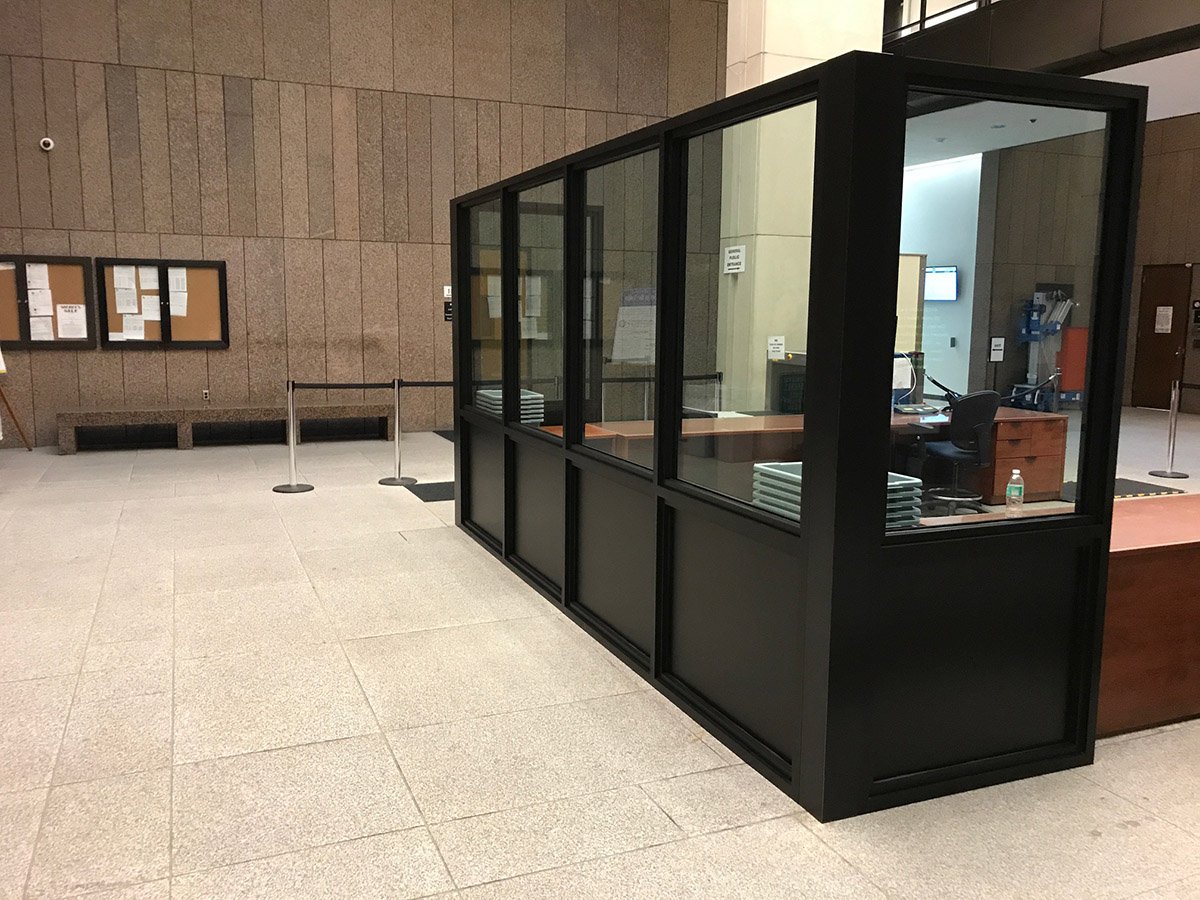
Ballistic Glass vs Ballistic Glazing: Is There a Difference?
Ballistic Glazing, or simply glazing, is a glass industry term that encompasses all types of transparent ballistic panels. As previously mentioned, bulletproof glazing may be made up of acrylic, polycarbonate, glass, or a combination such as Glass-Clad Polycarbonate.
Confused? Don’t worry, whether you call it bulletproof glass, bullet-resistant glazing, or ballistic glass—people will understand you’re speaking about transparent panels that stop bullets.
Ballistic Glass vs BulletproofGlass vs Bullet-Resistant Glass: Which Term is Correct?
Simply put, the proper industry term is bullet-resistant glass, but the most commonly used term is bulletproof glass. Ballistics, as defined in the Collins dictionary, is actually “the study of the movement of objects that are shot or thrown through the air, such as bullets fired from a gun.” In the real world, all three terms are used interchangeably.
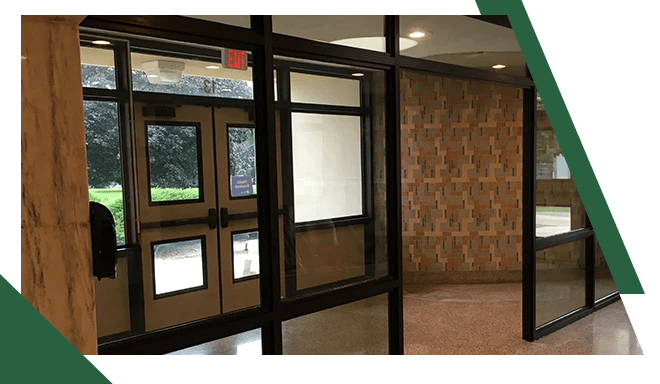
Understanding UL Rating System for Bullet-Resistant Materials
To be considered bullet-resistant, glazing designed for use in a bulletproof system goes through a series of tests to evaluate its ability to stop various ballistic attacks. The Underwriters Laboratories (UL) publishes the UL 752 Standard for Safety Bullet-Resisting Equipment—one the longest-standing and most nuanced rating systems. The 10 bullet-resistance levels of UL 752 are considered the “gold standard” in the industry and describe grades of ballistic resistance encompassing weapon calibers ranging from a 9mm handgun up to a .50 caliber rifle.
UL-rated materials are favored (or, in many cases, mandatory) in building construction. All TSS ballistic products have been tested by independent, third-party testing labs to ensure they perform up to, and typically beyond, the UL 752 standard.
Choosing the Right Product
When it comes to bulletproof glass, there are unlimited customization options. From level of protection to tinting to spall, it’s important to know what you need to make the right choice for your situation. We know how complex (and overwhelming) the sheer number of options can be, which is why we created the Ballistic Glazing Solutions Guide. This free, comprehensive ebook provides no-nonsense information and tips to help you identify the right bulletproof glass, whether you’re working on your first bulletproofing project or your fiftieth.

How Much Does Bulletproof Glass Cost?
Level 1 bullet-resistant security glazing starts at $50 per square foot, not including framing or installation. For the average comprehensive bulletproof security system, you may pay anywhere from $15,000 to $25,000. The cost of a ballistic system involves much more than the simple square footage of bullet-resistant glazing, and the estimates above may be higher or lower based on your project’s specific needs.
When considering your budget for a ballistic barrier project, remember that you’ll need to factor in the costs for each additional component of a complete system (like doors, wall panes, framing, and accessories). Your final quote will also include costs allocated for design, manufacturing, packaging, freight, and installation.
By offering custom-designed solutions for every unique situation and project, TSS makes sure you only pay for the products and services you need. The best way to determine the cost of your bulletproof system is to speak with a TSS ballistic expert!
BULLETPROOF GLASS OR SECURITY WINDOW FILM: WHICH STOPS BULLETS?
Security window film is often proposed as a less expensive, quick “bulletproof” solution for businesses interested in upgrading their security on a smaller budget. However, security window film is not a ballistically-rated material and will not stop bullets.
Your threat level and unique security concerns should always determine what security solutions are right for your business, office, or facility. We created a free guide to help you understand the differences between bullet-resistant glass and security window film and enable you to make the most informed decisions about your building’s physical security.

